Best Cheap Web Hosting Services in 2025: Getting the Best for Less
A reliable web host sets a solid foundation for your website’s success. Since there are numerous options available, we have removed the guesswork for you. Our list of the top cheap web hosting services will help you choose quality hosting without the high costs.
Cheap web hosting is a good option for beginners or small businesses looking to build an online presence without breaking the bank. However, pricing shouldn’t be the only factor you consider. Like the best web hosting providers, a cheap web hosting service should still provide reliable uptime, sufficient website resources, easy-to-use control panels and responsive customer support.
After conducting research and testing various cheap web hosts, we found ScalaHosting to be the best budget-friendly hosting company. Another great option is Bluehost, which offers feature-packed shared hosting plans. If you’re looking for the best cheap hosting services, keep reading to discover more top-rated providers.
-
03/20/2024
Rewritten to include more providers and an easier-to-read format.
How to Choose the Best Affordable Web Hosting Sites
Cheap web hosting generally refers to low-cost shared web hosting plans that allow you to host a website on a shared web server. These cheap hosting plans typically cost less than $10 per month. Here are some factors to consider when buying cheap web hosting:
- High uptime guarantee: This refers to the amount of time that web hosting companies guarantee your website will be up and running. Look for hosting providers that offer at least a 99% uptime guarantee.
- Sufficient storage and bandwidth: This ensures smooth performance and quick loading times for your website. A hosting plan with 10 to 50GB of disk space and a bandwidth of 100GB per month is sufficient for most small websites.
- Easy-to-use control panel: Choose a web hosting company that offers a user-friendly control panel, such as cPanel or Plesk. This makes it easier for you to manage your website, domain and other features. One-click installations are also a big plus.
- Security measures: Look for features like SSL certificates, regular backups and malware scanning to protect your website from potential threats.
- Reliable customer support: Make sure the web hosting provider you choose offers 24/7 support through different channels, such as live chat, phone and email. This is important if you have any problems or need assistance with your website.
- Scalability options: Consider your website’s future growth and choose a reputable web hosting provider that allows for easy upgrades to higher-tier plans.
The 10 Cheapest Web Hosting Sites
With a wide range of providers to choose from, we have narrowed down the options to the top 10 cheapest web hosting sites for various use cases. These providers often include additional benefits, such as free domain registration, a free SSL certificate and CDN.
Cheapest Web Hosting Solutions Compared
| Rank | Web Host | Monthly Price* | Renewal Price | Money-Back Guarantee | Trustpilot Review |
|---|---|---|---|---|---|
| 1. | ScalaHosting | $2.95 | $6.95 | Anytime | 5.0 out of more than 1,500 reviews |
| 2. | ChemiCloud | $2.95 | $9.95 | 45 days | 4.9 out of more than 600 reviews |
| 3. | SiteGround | $2.99 | $17.99 | 30 days | 4.8 out of more than 15,000 reviews |
| 4. | DreamHost | $2.59 | $5.99 | 97 days | 4.7 out of more than 5,000 reviews |
| 5. | Wix | Free | Free | Free forever | 4.6 out of more than 14,000 reviews |
| 6. | A2 Hosting | $2.99 | $12.99 | 30 days | 4.6 out of more than 2,500 reviews |
| 7. | Cloudways | $11 | $11 | 3-day free trial | 4.6 out of more than 2,000 reviews |
| 8. | IONOS | $1 (for 6 months) | $12 | 30 days | 4.5 out of more than 19,000 reviews |
| 9. | Namecheap | $1.58 | $4.48 | 30 days | 4.1 out of more than 14,000 reviews |
| 10. | Bluehost | $1.95 | $11.99 | 30 days | 4.0 out of more than 10,000 reviews |
1. ScalaHosting — Best Overall Cheap Web Hosting
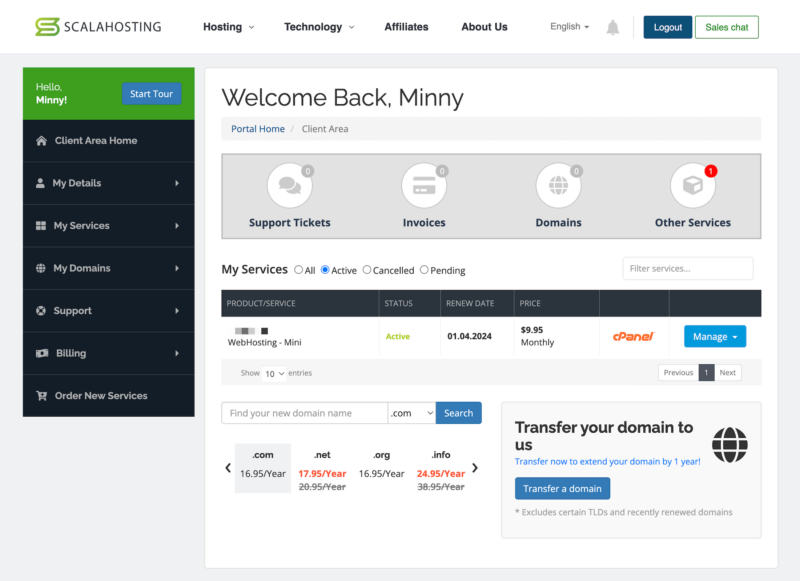
- Pricing: $2.95 per month
- Website: scalahosting.com
Pros:
- Feature-rich shared plans
- Great customer support
- Easy scalability
Cons:
- Restricts advanced security features in cloud hosting
- Has few data centers
ScalaHosting has been a key player in the hosting industry since 2007. The web hosting company provides a range of services, from shared hosting and reseller hosting to a managed cloud virtual private server (VPS).
Its shared hosting plans stand out for their feature-rich offerings, including automated daily backups, free SSL and CDN, as well as NVMe SSD storage technology for enhanced performance. However, there are only a few data center options for shared hosting.
Additionally, ScalaHosting guarantees 99.99% uptime. For added security, higher-tier plans include SShield, a real-time cybersecurity system. ScalaHosting provides 24/7 customer support with high satisfaction rates. If you outgrow your server resources, the service offers seamless upgrades to higher-tier plans and cloud hosting solutions.
Who Is It For?
ScalaHosting’s shared hosting plans are ideal for individuals and small to medium-sized businesses looking for reliable hosting solutions with responsive customer support. Contacting support through the ticket system is very quick, and we have received very helpful responses. Setting up a WordPress website is easy and fast via the Softaculous one-click installation.

individuals and small to medium-sized websites.
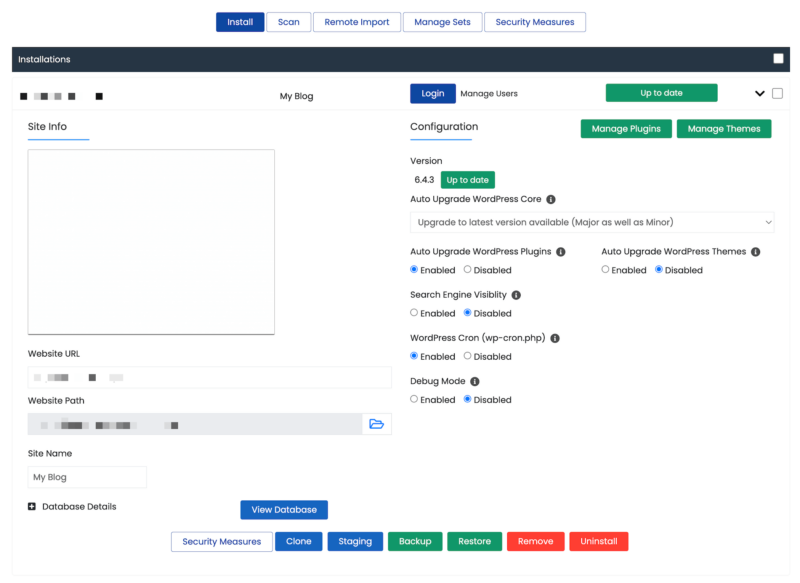
ScalaHosting Pricing & Value
ScalaHosting offers three shared hosting plans: Mini, Start and Advanced. The Mini plan costs $2.95 per month when billed annually but does not include a free domain. Upgrading to the Start or Advanced plans gets you a free domain name, multiple websites and additional security features. ScalaHosting also provides an anytime money-back guarantee.
| Plan | Mini | Start | Advanced | Entry Cloud |
|---|---|---|---|---|
| Features | 1. Shared hosting 2. One site 3. 10GB SSD storage 4. Free SSL 5. Unmetered bandwidth | 1. Shared hosting 2. Unlimited sites 3. 50GB SSD storage 4. Free domain 5. Real-time protection 6. SShield security | 1. Shared hosting 2. Unlimited sites 3. 100GB SSD storage 4. Free domain 5. Real-time protection 5. SShield security 6. Priority support | 1. Cloud hosting 2. Unlimited sites 3. 50GB SSD storage 4. Unmetered bandwidth 5. Dedicated IPs |
| Monthly Price | $9.95/month | $12.95/month | $15.95/month | $29.95/month |
| 12-Month Price | $2.95/month (renews at $6.95/month) | $5.95/month (renews at $8.95/month) | $19.95/month | |
| 36-Month Price | $2.95/month (renews at $6.95/month) | $5.95/month (renews at $8.95/month) | $9.95/month (renews at $13.95/month) | $14.95/month |
2. ChemiCloud — Shared Hosting Built for Speed
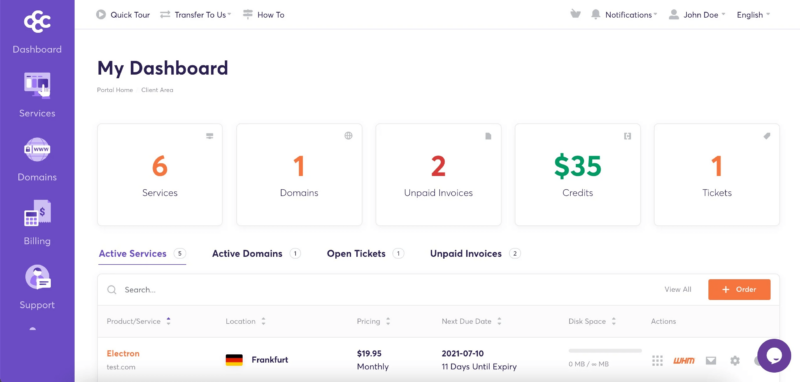
- Pricing: $2.95 per month
- Website: chemicloud.com
Pros:
- Multiple server locations
- Free migration service
- Speedy web host
Cons:
- Limited SSD storage
- High renewal prices
ChemiCloud, a relatively new player in the hosting industry, has gained recognition and popularity for its strong focus on performance and customer support. ChemiCloud utilizes LiteSpeed Cache for enhanced website speed, Cloudflare CDN for improved content delivery and NVMe storage for faster file access.
To safeguard websites from potential threats, ChemiCloud provides a free SSL certificate and firewall protection, as well as malware detection on higher-tier plans. Additionally, the company has multiple servers in 17 locations and a 99.99% uptime guarantee. ChemiCloud also stands out among other cheap web hosting providers due to its reliable customer support.
Who Is It For?
While a typical drawback of shared hosting is slower loading times due to the sharing of server resources, ChemiCloud’s web hosting is optimized for fast content delivery. This makes ChemiCloud well-suited for businesses, bloggers and e-commerce websites looking for a reliable and affordable web hosting service.
Furthermore, ChemiCloud offers a free and fast migration service as well as a user-friendly dashboard that allows for easy navigation and website management. You can use the website builder or simply set up WordPress with the Softaculous one-click installation.
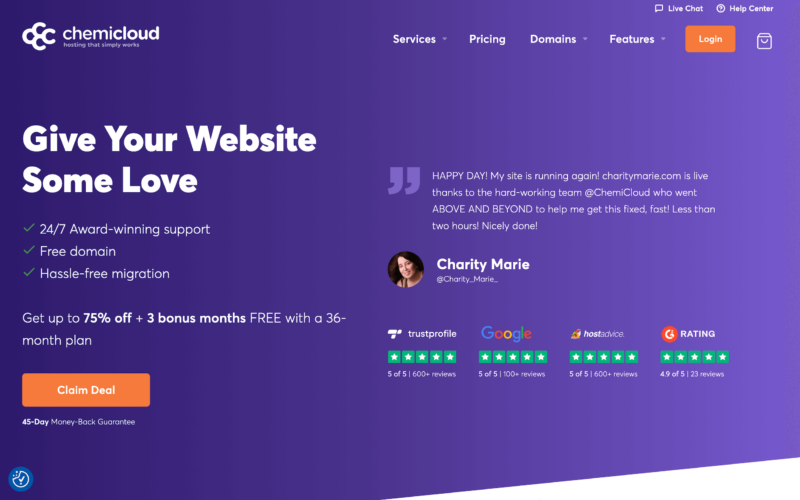
ChemiCloud Pricing & Value
ChemiCloud offers three plans for shared or WordPress hosting: Starter, Pro and Turbo. The Starter plan is priced at $2.95 per month when billed triennially and allows for one website. With its enhanced performance and security features, the Turbo plan is recommended for hosting multiple websites. You can test ChemiCloud risk-free using its 45-day money-back guarantee.
| Plan | Starter | Pro | Turbo |
|---|---|---|---|
| Features | 1. One site 2. 20GB SSD storage 3. Free domain 4. SSL 5. Unlimited bandwidth | 1. Unlimited sites 2. 30GB SSD storage 3. Free domain 4. SSL 5. Unlimited bandwidth 6. 2x more CPU/RAM | 1. Unlimited sites 2. 40GB SSD storage 3. Free domain 4. SSL 5. Unlimited bandwidth 6. 3x more CPU/RAM 7. Free malware scanner 8. Free malware removal |
| Monthly Price | $13.95/month | $18.95/month | $22.95/month |
| 12-Month Price | $4.95/month (renews at $13.95/month) | $5.95/month (renews at $18.95/month) | $6.95/month (renews at $22.95/month) |
| 36-Month Price | $2.95/month (renews at $9.95/month) | $3.95/month (renews at $15.95/month) | $4.95/month (renews at $19.95/month) |
3. SiteGround — Cheap Web Hosting for E-Commerce
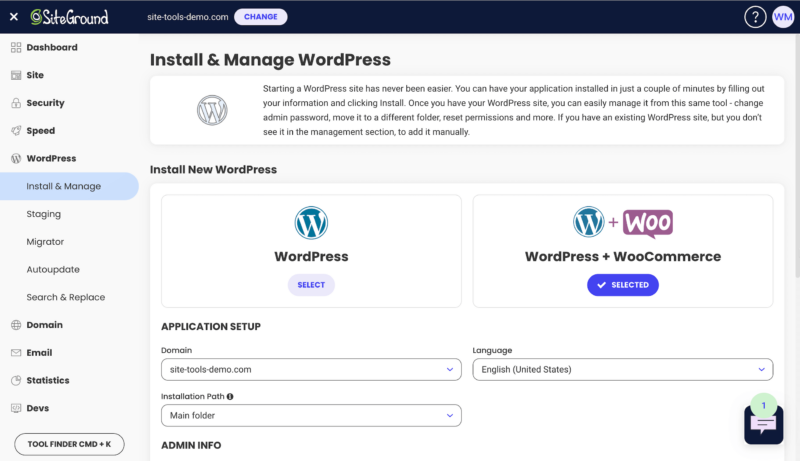
- Pricing: $2.99 per month
- Website: siteground.com
Pros:
- Easy store management
- Great customer support
- Uses renewable energy
Cons:
- High renewal prices
- Limited storage space
SiteGround is a good, low-cost hosting service for professionals, especially those who run e-commerce websites. The services include preinstalled WordPress with the WooCommerce plugin, automatic updates, and tools for easy setup and management of online stores.
Additionally, SiteGround’s hosting is performance-optimized with features such as a free CDN and NGINX cache for faster loading times. Security features include SSL certificates, daily backups and a web application firewall (WAF). Each plan comes with free domain registration and site transfer services. SiteGround also offers 24/7 customer support with high satisfaction.
Who Is It For?
SiteGround is a great option for businesses looking for hassle-free web hosting services, as its managed WordPress hosting handles all the technical aspects of website management. With the WooCommerce plugin, businesses can easily create and manage their online stores.
We appreciate SiteGround’s user-friendly dashboard, which makes it easy to navigate and manage websites. Moreover, the support team is responsive, providing immediate assistance through live chat.

SiteGround Pricing & Value
SiteGround provides three hosting plans. The most affordable web hosting plan is the StartUp plan, which starts at $2.99 per month when billed annually. This plan includes one website, 10GB of SSD and unlimited databases. It’s important to note that the renewal price is quite high. You can try SiteGround’s web hosting services with its 30-day money-back guarantee.
| Plan | StartUp | GrowBig | GoGeek |
|---|---|---|---|
| Features | 1. One site 2. 10GB SSD storage 3. Free domain 4. SSL 5. Unlimited traffic | 1. Unlimited sites 2. 20GB SSD storage 3. Free domain 4. SSL 5. Unlimited traffic | 1. Unlimited sites 2. 40GB SSD storage 3. Free domain 4. SSL 5. Unlimited traffic 6. Priority support |
| Monthly Price | $24.99/month | $34.99/month | $49.99/month |
| 12-Month Price | $2.99/month (renews at $17.99/month) | $4.99/month (renews at $29.99/month) | $7.99/month (renews at $44.99/month) |
| 36-Month Price | $7.49/month (renews at $17.99/month) | $12.49/month (renews at $29.99/month) | $19.99/month (renews at $44.99/month) |
4. DreamHost — Low-Cost WordPress Hosting
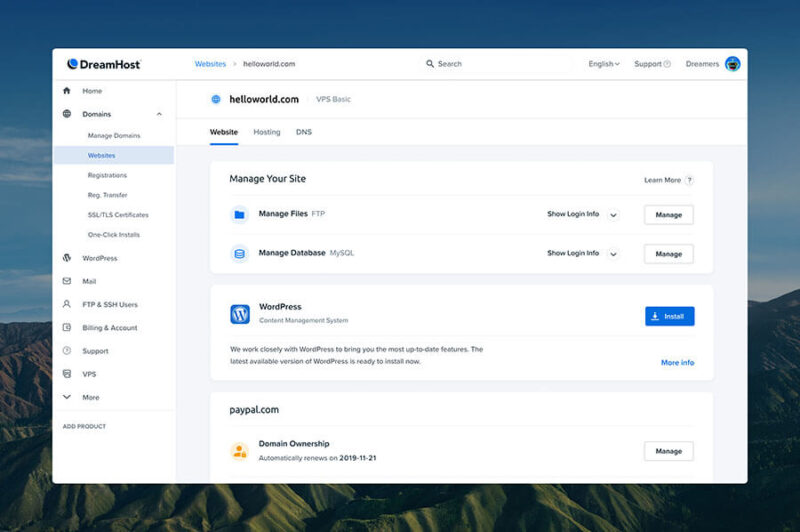
- Pricing: $2.59 per month
- Website: dreamhost.com
Pros:
- Recommended by WordPress
- User-friendly control panel
- 100% uptime guarantee
Cons:
- Lacks WordPress staging
- Lacks security details
DreamHost is one of the cheaper web hosting providers recommended by WordPress.org. Its shared hosting plans include a WordPress website builder and automatic WordPress updates. You’ll also get a free custom domain with domain privacy and a free SSL certificate.
Moreover, DreamHost provides a 100% uptime guarantee and daily backups, although specific information on security measures is somewhat lacking on its website. Support is available through live chat, a 24/7 ticket system and phone support. We found the support team to be knowledgeable and responsive, as they provided quick answers to our issues.
Who Is It For?
DreamHost’s web hosting services are tailored for beginners looking to create small to medium-sized websites. You can easily navigate and manage your websites thanks to the user-friendly, custom-built control panel. Plus, the one-click installation feature lets you quickly set up popular platforms such as WordPress.

DreamHost Pricing & Value
DreamHost offers two shared hosting options, including Shared Starter and Shared Unlimited. Starting at $2.59 per month, the Shared Starter plan provides hosting for one website with unmetered bandwidth and 50GB of SSD storage. The Shared Unlimited plan offers unlimited websites and storage. DreamHost also has a generous 97-day money-back guarantee.
| Plan | Shared Starter | Shared Unlimited |
|---|---|---|
| Features | 1. One site 2. 50GB SSD storage 3. Free domain 4. SSL 5. Unlimited traffic | 1. Unlimited sites 2. Unlimited SSD storage 3. Free domain 4. SSL 5. Unlimited traffic 6. Unlimited databases |
| Monthly Price | $4.95/month (for 3 months and then renews at $7.99/month) | $8.95/month (for 3 months and then renews at $13.99/month) |
| 12-Month Price | $2.95/month (renews at $6.99/month) | $2.95/month (renews at $12.99/month) |
| 36-Month Price | $2.59/month (renews at $5.99/month) | $3.95/month (renews at $10.99/month) |
5. Wix — Best Free Web Hosting Service

allows for easy editing and customization.
- Pricing: Free
- Website: wix.com
Pros:
- Easy-to-use website builder
- Customizable site templates
- Good free plan
Cons:
- Not suitable for larger sites
- Has storage limits
Wix is a user-friendly website builder that makes it easy for anyone to create a website. You can quickly get started with over 900 free, customizable website templates. Wix’s free website hosting includes 500MB of storage, 500MB of monthly bandwidth and built-in search engine optimization (SEO) tools.
For security measures, Wix provides an SSL certificate, DDoS protection and a 99.9% uptime guarantee. Its customer support options include live chat, callback services and an extensive knowledgebase. We tested the live chat feature and received fast, helpful responses to our questions.
Who Is It For?
Wix is a great option for creating blogs, simple online stores, portfolios and small business websites. The intuitive drag-and-drop website builder enables anyone to build a custom site, regardless of their web design expertise. Designing a website and adding content like text and images is also straightforward.

Wix Pricing & Value
Wix is free to use for as long as you need it. When your site outgrows the storage or bandwidth limits, you can upgrade to the premium plans, which include Light, Core, Business and Business Elite. The prices start at $17 per month for the annual plan. Wix also offers a 14-day money-back guarantee on its paid plans.
| Plan | Light | Core | Business | Business Elite |
|---|---|---|---|---|
| Features | 1. 2 collaborators 2. 2GB storage 3. Free domain (1 year) | 1. 5 collaborators 2. 50GB storage 3. Free domain (1 year) 4. Basic analytics | 1. 10 collaborators 2. 100GB of storage 3.Free domain (1 year) 4. Standard analytics | 1. 15 collaborators 2. Unlimited storage 3. Free domain (1 year) 4. Advanced analytics |
| Monthly Price | $24/month | $36/month | $43/month | $172/month |
| 12-Month Price | $17/month | $29/month | $36/month | $159/month |
| 24-Month Price | $14/month | $24/month | $29/month | $121/month |
| 36-Month Price | $12/month | $21/month | $26/month | $110/month |
6. A2 Hosting — Cheap Reliable Web Hosting

- Pricing: $2.99 per month
- Website: a2hosting.com
Pros:
- Responsive customer support
- High-performance servers
- Lots of site storage
Cons:
- Few security details
- High renewal rates
A2 Hosting offers cheap web hosting services known for their high-speed performance and reliability. It provides many hosting options, including shared and VPS hosting as well as dedicated servers. A standout feature of A2 Hosting is its Turbo servers, which leverage LiteSpeed server technology. It also has NVMe drives for faster page load times and improved website performance.
Moreover, A2 Hosting’s shared hosting package includes a free SSL certificate and a 99.9% uptime guarantee. However, we found little information about its security. A2 Hosting offers 24/7 assistance via live chat, phone and email tickets. Customers on Trustpilot praise A2 Hosting’s prompt and efficient support. It also provides a free migration service for one website.
Who Is It For?
A2 Hosting is ideal for small to medium-sized businesses that prioritize website speed and performance. This can significantly enhance the user experience and positively impact SEO.
Additionally, A2 Hosting’s account dashboard is clean, though it may not be as visually appealing as some other providers. You can also use its website builder with premade templates to kickstart your website.

A2 Hosting Pricing & Value
A2 Hosting offers four web hosting plans, including Startup, Drive, Turbo Boost and Turbo Max. The entry-level Startup plan is priced at $2.99 per month when billed annually, and it comes with one website and 100GB of SSD. For enhanced website performance, you can opt for the Turbo Boost or Turbo Max plans. A2 Hosting also offers a 30-day money-back guarantee.
| Plan | Startup | Drive | Turbo Boost | Turbo Max |
|---|---|---|---|---|
| Features | 1. One website 2. 100GB of SSD 3. Free SSL 4. Unlimited email accounts | 1. Unlimited websites 2. Unlimited storage 3. Free automatic backupS 4. Unlimited databases | 1. Unlimited websites 2. Unlimited NVMe SSD 3. Turbo servers | 1. Unlimited websites 2. Unlimited NVMe SSD 3. Turbo servers 4. 5x more resources |
| Monthly Price | $11.99/month (renews at $12.99/month) | $12.99/month (renews at $15.99/month) | $19.99/month (renews at $24.99/month) | $24.99/month (renews at $29.99/month) |
| 12-Month Price | $2.99/month (renews at $131.88/12 months) | $5.99/month (renews at $167.88/12 months) | $6.99/month (renews at $263.88/12 months) | $14.99/month (renews at $323.88/12 months) |
| 24-Month Price | $5.99/month (renews at $263.76/24 months) | $7.99/month (renews at $335.76/24 months) | $9.99/month (renews at $527.76/24 months) | $16.99/month (renews at $647.76/24 months) |
| 36-Month Price | $4.99/month (renews at $395.64/36 months) | $5.99/month (renews at $503.64/36 months) | $6.99/month (renews at $791.64/36 months) | $14.99/month (renews at $971.64/36 months) |
7. Cloudways — Affordable Managed Cloud Hosting
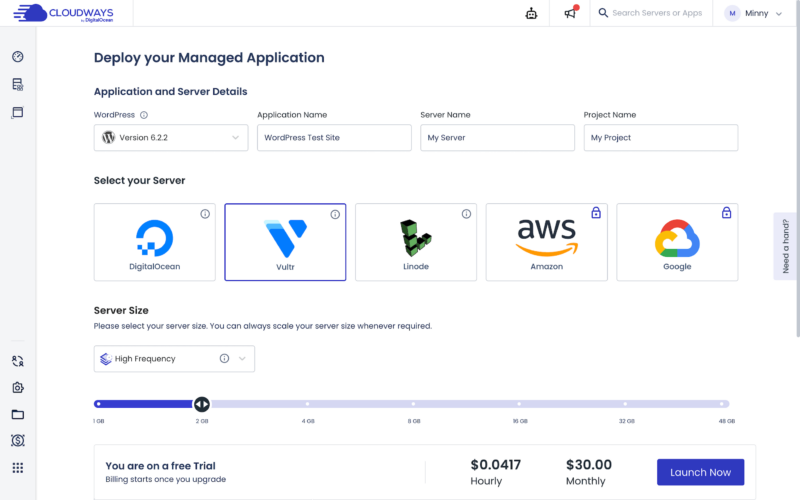
- Pricing: $11 per month
- Website: cloudways.com
Pros:
- Enhanced site performance
- No multi-year commitment
- Easy scalability
Cons:
- Must pay for email hosting
- Requires technical knowledge
Cloudways is a managed cloud web hosting service that supports top cloud infrastructure providers like DigitalOcean, AWS and Google Cloud. It optimizes servers for better performance and faster load times, offering dedicated environments and the ability to host unlimited websites.
Security features include firewalls, SSL certificates, real-time server monitoring and optional add-ons like Cloudflare Enterprise. Cloudways offers a good knowledgebase, 24/7 customer support, a ticketing system and free website migration for one site. Technical support responded to our live chat request in minutes and quickly solved our issue.
Who Is It For?
If you want your website to perform better than it would on shared hosting without overspending, Cloudways is an excellent option. Setting up a server on Cloudways requires a little technical knowledge, but you can always contact the support team for assistance. Once set up, deploying a WordPress site is quick and easy, thanks to its user-friendly interface.

Cloudways Pricing & Value
Cloudways offers straightforward pricing plans without introductory prices, starting at $11 per month with no long-term commitment. This pay-as-you-go model allows you to easily upgrade as your website grows. Additionally, Cloudways provides a three-day free trial for you to test its services.
| Plan | DigitalOcean Standard | DigitalOcean Premium | AWS | Google Cloud |
|---|---|---|---|---|
| Features | 1. 1GB of RAM 2. 25GB storage 3. 1TB bandwidth | 1. 1GB of RAM 2. 25GB storage 3. 1TB bandwidth | 1. 2GB of RAM 2. 20GB storage 3. 2GB bandwidth | 1. 1.7GB of RAM 2. 20GB storage 3. 2GB bandwidth |
| Monthly Price | $11/month | $14/month | $38.56/month | $37.45/month |
8. IONOS — Best Cheap Web Hosting for Unlimited Everything
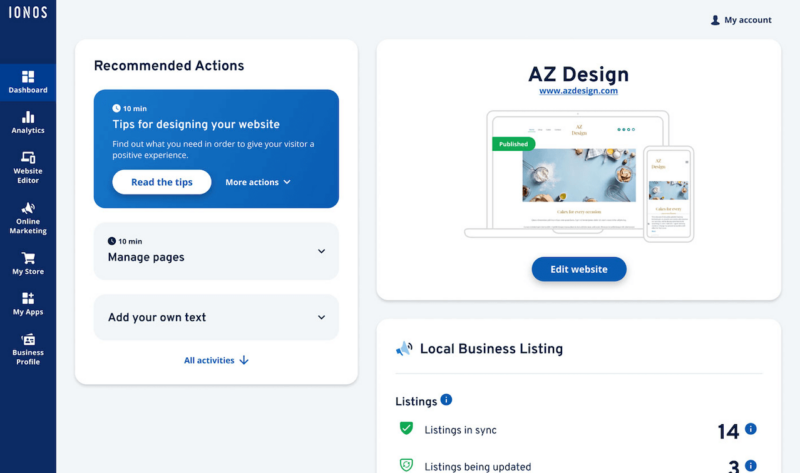
- Pricing: $1 per month
- Website: ionos.com
Pros:
- Comprehensive website tools
- Cheap introductory prices
- Good security measures
Cons:
- Lacks a site migration service
- Poor customer support
IONOS provides web hosting deals at competitive prices with generous resources. All shared hosting plans come with a free one-year domain, unlimited traffic, a free SSL certificate and website analytics. Additionally, IONOS offers comprehensive tools for website creation and management, like a website builder, an SEO optimization tool and email marketing solutions.
IONOS ensures security through malware scans, DDoS protection, daily backups and a 99.99% uptime guarantee. Customers can access support via live chat, email, phone and a help center. We did not have a very impressive experience with customer support. Nevertheless, there are positive reviews for its customer support from customers on platforms like Trustpilot.
Who Is It For?
IONOS is a suitable option for individuals and small businesses. The account manager’s interface is clean and easy to navigate. The hosting company also makes website creation a seamless process with one-click installations for popular platforms, such as WordPress and Joomla.
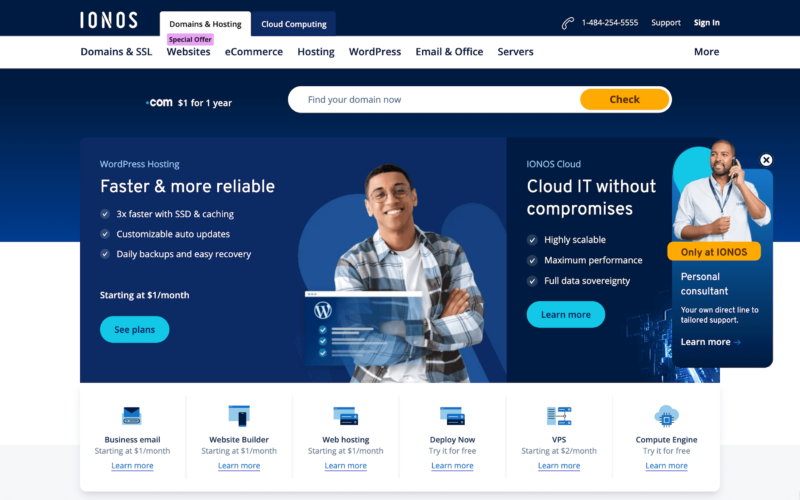
IONOS Pricing & Value
IONOS offers affordable introductory prices. The Plus plan stands out with an affordable introductory price of $1 per month for the first six months and a reasonable renewal rate. This hosting package includes unlimited storage, websites and databases, providing great value for users. Additionally, all of IONOS’ hosting plans come with a 30-day money-back guarantee.
| Plan | Essential | Starter | Plus | Ultimate |
|---|---|---|---|---|
| Features | 1. One website 2. 10GB of SSD 2. 10 databases 3. Free domain 4. Free SSL 5. Daily backups 6. Daily recovery | 1. 10 websites 2. 100GB of SSD 3. 50 databases 4. Free domain 5. Free SSL 6. Daily backups 7. Daily recovery | 1. Unlimited websites 2. Unlimited storage 3. Unlimited databases 4. Enhanced CPU | 1. Unlimited websites 2. Unlimited storage 3. Unlimited databases 4. Maximum CPU |
| 12-Month Price | $4/month (renews at $6/month) | $6/month (renews at $8/month) | $1/month (renews at $12/month) | $10/month (renews at $16/month) |
9. Namecheap — Cheapest Hosting Choice for Multiple Sites
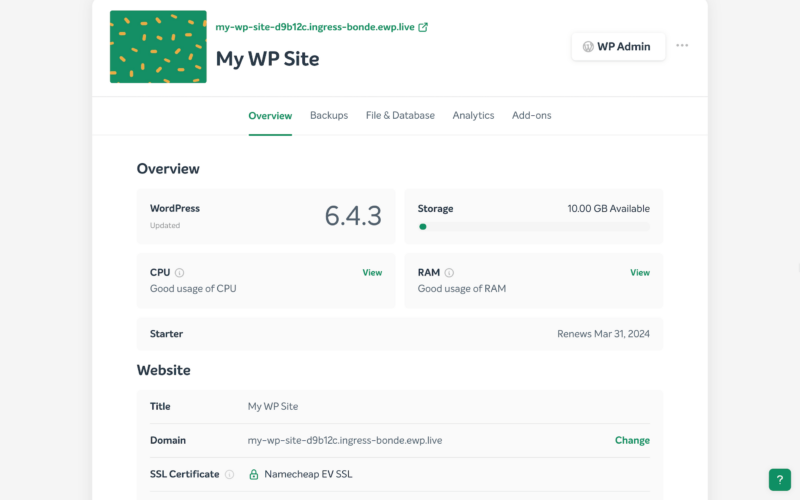
- Pricing: $1.58 per month
- Website: namecheap.com
Pros:
- Affordable prices
- User-friendly interface
- Good security measures
Cons:
- Limited data centers
- Not suitable for larger businesses
Namecheap is widely recognized for its domain registration services. It also offers cheap web hosting services, including shared hosting, WordPress hosting, VPS hosting and dedicated servers. Its shared hosting packages include free domain registration with privacy protection, SSL certificates and unmetered bandwidth.
For security features, Namecheap provides cPanel 2FA (two-factor authentication), automatic backups, DDoS protection and CDN while also guaranteeing 100% uptime. Customers can reach its support team 24/7 through live chat or the ticketing system. We found that the live chat assistance usually responds quickly, but some interactions weren’t very helpful.
Who Is It For?
Namecheap’s hosting services are suitable for blogs, personal sites and small sites. One standout feature is the user-friendly interface and straightforward setup process. You can swiftly navigate the hosting dashboard and manage your websites with ease.
Plus, Namecheap provides a website builder and the Softaculous app installer for getting WordPress sites online. The provider also has a marketplace where you can find many add-ons and marketing tools to run your websites.
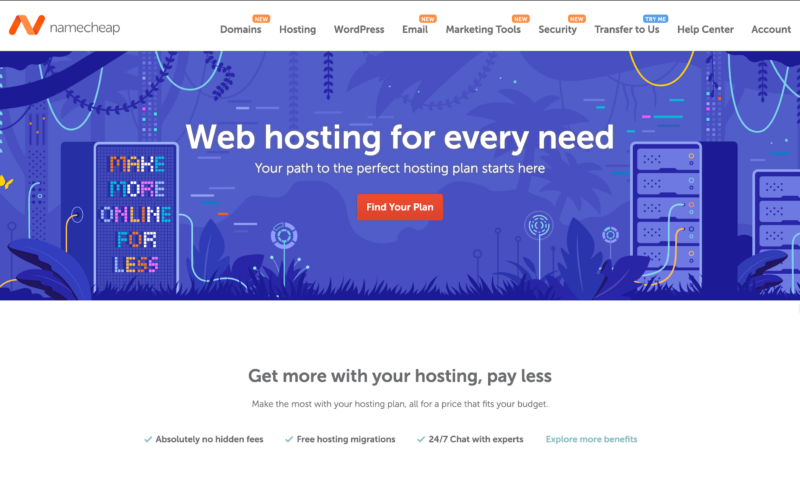
Namecheap Pricing & Value
Namecheap offers the cheapest web hosting service, with its Stellar hosting plan starting at $1.58 per month for a 24-month billing cycle. This hosting plan includes three websites, a 20GB SSD and a low renewal rate. The Stellar Plus and Stellar Business plans are recommended if you want unlimited sites and more resources. Namecheap also offers a 30-day money-back guarantee.
| Plan | Stellar | Stellar Plus | Stellar Business |
|---|---|---|---|
| Features | 1. 3 sites 2. 20GB of SSD 3. 30 mailboxes 4. Free domain 5. Free SSL | 1. Unlimited sites 2. Unmetered SSD 3. Unlimited mailboxes 4. Automatic backups | 1. Unlimited sites 2. 50GB of SSD 3. Unlimited mailboxes 4. Automatic backups 5. Cloud storage |
| Monthly Price | $4.48/month | $6.48/month | $9.48/month |
| 12-Month Price | $1.98/month (renews at $4.48/month) | $2.98/month (renews at $6.48/month) | $4.98/month (renews at $9.48/month) |
| 24-Month Price | $1.58/month (renews at $4.48/month) | $2.28/month (renews at $6.48/month) | $4.48/month (renews at $9.48/month) |
10. Bluehost — Best Cheap Hosting Service for WordPress Beginners
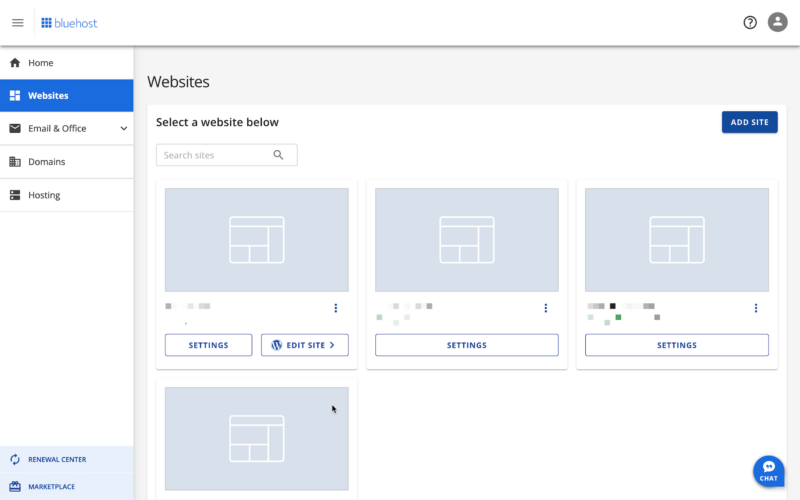
- Pricing: $1.95 per month
- Website: bluehost.com
Pros:
- Easy to use account manager
- One-click WordPress install
- Free SSL & CDN
Cons:
- High renewal prices
- Unimpressive performance
Established in 2003, Bluehost is a trustworthy web hosting provider that WordPress.org recommends. Its services include shared hosting, VPS hosting and dedicated server hosting. Bluehost’s web hosting service is ideal for WordPress beginners.
All shared and managed WordPress hosting plans come with a free domain name for the first year, SSD storage starting at 10GB, free CDN and SSL. Higher-tier plans offer additional perks such as domain privacy protection and daily website backups for the initial year, as well as malware scanning. However, we find that Bluehost provides few server details on the website.
Customer support at Bluehost is easily accessible via live chat and phone (the latter is available for the Choice Plus plan and above). Although responses were slow during busy times and the support agents weren’t always very knowledgeable, the service quality is still decent.
Who Is It For?
Bluehost is suitable for WordPress beginners but may not be the best option for those seeking top-notch performance. It has one of the most intuitive account dashboards available. Setting up and maintaining a WordPress website is easy with one-click installation and automatic updates. You can also conveniently manage basic settings within the account manager.

just getting started with their WordPress site.
Bluehost Pricing & Value
Bluehost’s shared hosting plans include Basic, Choice Plus, Online Store and Pro. The Basic plan starts at an introductory price of $1.95 per month when billed annually. However, renewal pricing is much higher, so you should carefully consider your long-term budget when choosing a plan. Bluehost offers a 30-day money-back guarantee so you can try its services risk-free.
| Plan | Basic | Choice Plus | Online Store | Pro |
|---|---|---|---|---|
| Features | 1. One website, 2. 10GB of SSD, 3. Free SSL (first year) 4. live chat support | 1. 3 websites, 2. 40GB of SSD 3. Chat/phone support 4. Free SSL 5. Malware scanning | 1. 3 websites 2. 40GB of SSD 3. Chat/phone support 4. Sell products online 5. Free SSL 6. Malware scanning | 1. 5 websites 2. 100GB of SSD 3. High traffic optimized |
| 12-Month Price | $1.95/month (renews at $11.99/month) | $4.45/month (renews at $21.99/month) | $8.95/month (renews at $26.99/month) | $12.95/month (renews at $28.99/month) |
| 36-Month Price | $3.95/month (renews at $9.99/month) | $6.45/month (renews at $19.99/month) | $11.95/month (renews at $25.99/month) | $17.95/month (renews at $26.99/month) |
Final Thoughts: Inexpensive Web Hosts
While price is a significant factor when selecting budget hosting for your website, it’s also important to consider the entire range of cheap web hosting packages, including uptime guarantees, features, bandwidth, storage, security and support. With the right cheap hosting plan, you can launch a successful site without exceeding your budget.
ScalaHosting stands out as the top choice for cheap web hosting thanks to its low pricing, generous features and reliable performance. Additionally, we recommend ChemiCloud for websites that prioritize speed, while SiteGround excels at providing exceptional services for managed WordPress sites.
What cheap web host do you currently use? Are you happy with its service? Do you have any other tips for choosing cheap web hosts? Let us know in the comments below, and thank you for reading!
FAQ: Cheap Hosting Companies for Your Website
Some of the best and cheapest web hosts for hosting a website include ScalaHosting, ChemiCloud and DreamHost, which offer shared hosting plans starting at under $3 per month.
Namecheap offers the cheapest hosting at just $1.58 per month for multiple shared hosting accounts. At $1.95 per month, Bluehost is one of the recommended web hosts with generous features.
You can host a simple website for free using services like GitHub Pages, Vercel or Netlify. However, these have limitations and lack the features of paid web hosts. Alternatively, you can build a free website with a website builder like Wix.
Some of the most affordable VPS and dedicated server hosts include Hostwinds, DreamHost and Namecheap. Their managed VPS plans start at around $10 to $20 per month. For dedicated servers, prices start at under $100 per month.


